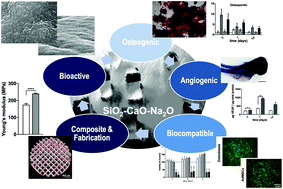Phosphorous pentoxide-free bioactive glass exhibits dose-dependent angiogenic and osteogenic capacities which are retained in glass polymeric composite scaffolds†
Abstract
Bioactive glasses (BGs) are attractive materials for bone tissue engineering because of their bioactivity and osteoinductivity. In this study, we report the synthesis of a novel phosphorous pentoxide-free, silicate-based bioactive glass (52S-BG) composed of 52.1% SiO2, 23.2% Na2O and 22.6% CaO (wt%). The glass was thoroughly characterized. The biocompatibility and osteogenic properties of 52S-BG particles were analyzed in vitro with human adipose-derived mesenchymal stem cells (AdMSCs) and human osteoblasts. 52S-BG particles were biocompatible and induced mineralized matrix deposition and the expression of osteogenic markers (RunX2, alkaline phosphatase, osteocalcin, osteopontin, collagen I) and the angiogenic marker vascular endothelial growth factor (VEGF). Angiogenic properties were additionally confirmed in a zebrafish embryo model. 52S-BG was added to poly-ε-caprolactone (PCL) to obtain a composite with 10 wt% glass content. Composite PCL/52S-BG scaffolds were fabricated by additive manufacturing and displayed high porosity (76%) and pore interconnectivity. The incorporation of 52S-BG particles increased the Young's modulus of PCL scaffolds from 180 to 230 MPa. AdMSC seeding efficiency and proliferation were higher in PCL/52S-BG compared to PCL scaffolds, indicating improved biocompatibility. Finally, 52S-BG incorporation improved the scaffolds’ osteogenic and angiogenic properties by increasing mineral deposition and inducing relevant gene expression and VEGF protein secretion. Overall, 52S-BG particles and PCL/52S-BG composites may be attractive for diverse bone engineering applications requiring concomitant angiogenic properties.



 Please wait while we load your content...
Please wait while we load your content...